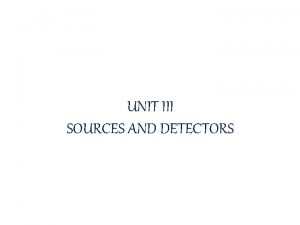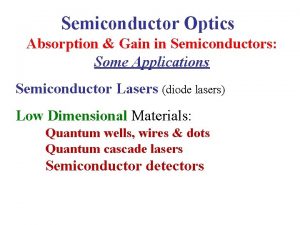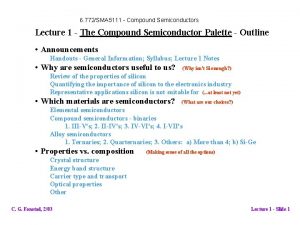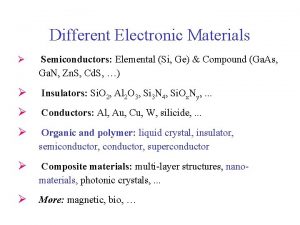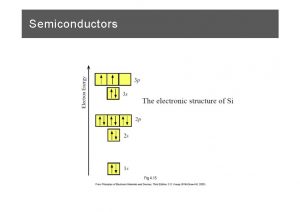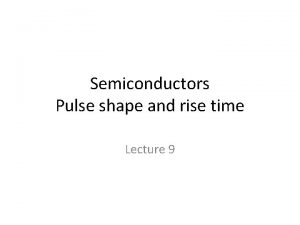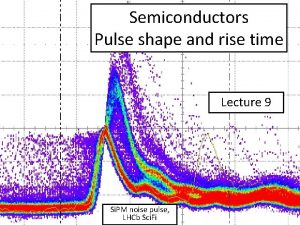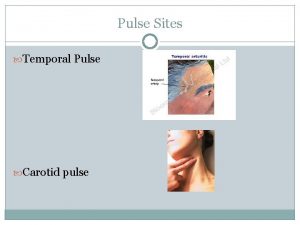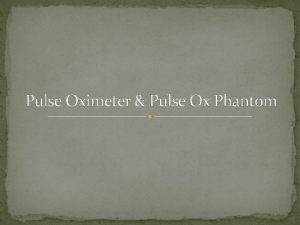Semiconductors Pulse shape and rise time Lecture 9








- Slides: 8

Semiconductors Pulse shape and rise time Lecture 9

Pulse shape As in gas detectors, pulse from induction by movement of charges rather than actual collection of charge itself. Example: pn-junction, p-type material, heavily doped with n-type on one side. The depletion zone almost entirely built in the p-zone. Proceed as for gas detector: Conservation of energy, charge has potential energy moving by dx changes energy. For a volume without charge the following equation can be written. This is also valid in the presence of a spacecharge. Energy of capacitor: use: • Assume isolated system, no resupply by external power supply • Energy conservation requires change in potential energy results in a change of energy stored in capacitor. • Kinetic energy of electrons is negligible.

Pulse shape Together: Electric field in depletion zone: replace NA by conductivity

Electron-Hole pair creation at x=x 0: Electron drift toward n+ with: (diff. eq. ) Collection time: Charge collected: ==> Hole drifts towards p with: ==> Collection time is infinite! Charge collected: (The change in charge in time is the charge collected. Integration done directly next page) ….

Integration of collected charge on one side and on x on the other

Total charge collected: τ determines the rise time of signal! Typically τ≈1 ns

Semiconductor detectors in nuclear and particle physics Semiconductor detectors are widely used in both nuclear and particle physics. Depending on the energies involved, two completely different applications have been developed: Low energy (ke. V, Me. V) (≈nuclear physics) ionizing particle (or photon) is stopped in Si or Ge => measure the total energy deposited “calorimeter” Si (Ge) diode detectors Si-diffused junction diode -surface barrier detector (SSB) -ion-implanted diode -lithium drifted Si diode (Si. Li) Ge: -Lithium drifted Ge diode (Ge. Li) - high purity Ge (HPGe) High energy (>100 Me. V) (≈particle physics) ionizing particle traverses Si layer => measure the position of the trajectory (and d. E/dx) “tracking chamber” Si microstrip (or derivatives) detectors -Si microstrip detectors, single or double sided -Si pixel detectors -Si drift chambers

Germanium detectors Ge preferred over Si for γ detection (nuclear physics) because of larger photoelectric cross section, Þfactor ~60 higher efficiency but smaller energy gap than Si (0. 7 e. V vs 1. 1 e. V @ 300 K) => detectors must be cooled during operation. 1) Lithium – drifted Germanium diode Ge. Li: Compensation by Lithium-drifting technique (as for Si) => thickness up to 15 -200 mm attainable, often coaxial geometry to maximize sensitive volume. Main problem: must be cooled at all times, high mobility of Li ions in Ge. 2) High-Purity Germanium HPGe: High purity Germanium now available (<1010 cm-3 impurities) Þ intrinsic Germanium (doped by ion implantation), about the same properties as Ge. Li, but cooling only needed during measurement (small energy gap) Þ HPGe have now replaced Ge. Li as standard detectors.
 Tricky dick
Tricky dick Rise and rise until lambs become lions
Rise and rise until lambs become lions Raise and rise again until lambs become lions
Raise and rise again until lambs become lions Rise and rise again until lambs become lions origin
Rise and rise again until lambs become lions origin 01:640:244 lecture notes - lecture 15: plat, idah, farad
01:640:244 lecture notes - lecture 15: plat, idah, farad Direct and indirect band gap semiconductors
Direct and indirect band gap semiconductors Optical loss and gain in semiconductors
Optical loss and gain in semiconductors Elemental and compound semiconductors
Elemental and compound semiconductors Elemental and compound semiconductors
Elemental and compound semiconductors





